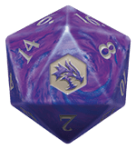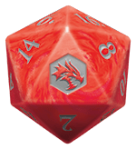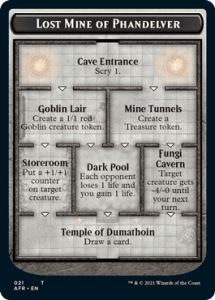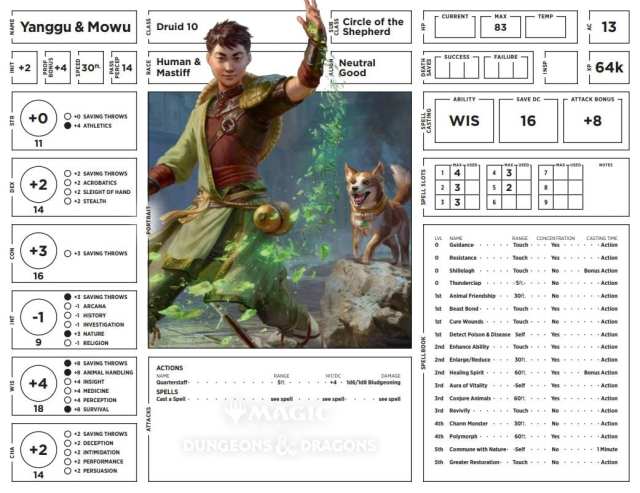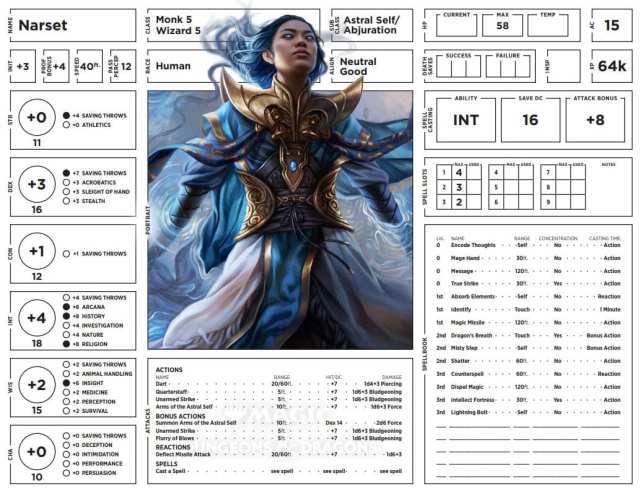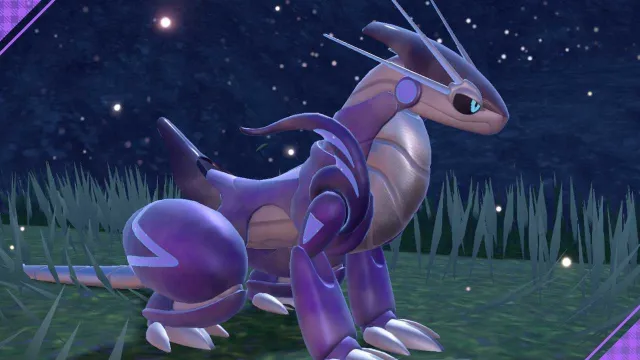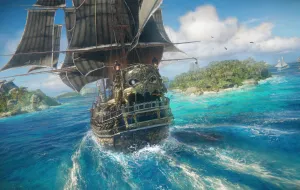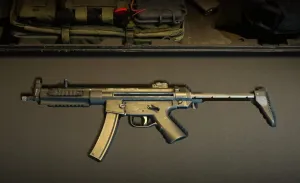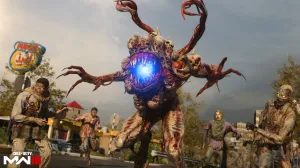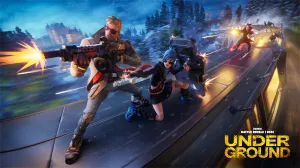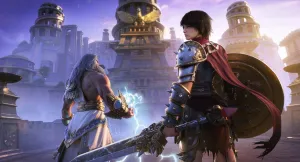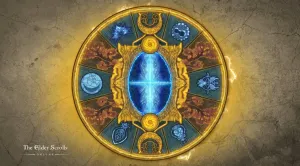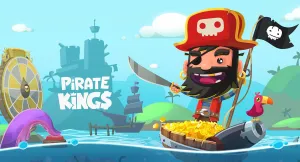Wizards of the Coast recently announced its latest Magic: The Gathering card set. This Magic: the Gathering set, titled “Adventures in the Forgotten Realms” is a brand collaboration with Dungeons & Dragons (D&D). Both hailing from the same company, this is the first cross-collaboration MTG and D&D have delivered. The card set will be available in stores and in-game on Magic: The Gathering Arena from July 23.
We wanted to understand a bit more about the set, so we caught up with some of the development team. The team gave us some insights into the creative process. We also learned about the artwork behind the cards, and some background on the game mechanics arriving with this crossover.
Collaborating with D&D
Since MTG and D&D have the same parent company, one would think a collaboration between the two brands wouldn’t be too farfetched. So, we asked Meris Mullaley, the Worldbuilding Design Manager, to give us some insight into how the collaboration came about. Firstly, Meris said the team did “a happy dance,” which seems like a good place to start. Once the happy dance is over, then it’s time to start planning, as Meris told Upcomer:
“Step two [is to] make a list of what a Magic set needs and compare it to a list of what D&D/Forgotten Realms has to offer.”

Once you’ve got your list, Meris then says it’s important to “talk to D&D partners and ask questions about the ways we want to bridge the gaps between those lists. Sometimes those solutions are game mechanics, sometimes they are creative flavor or art. This is really one of the most important steps. We also had a lot of D&D knowledge among the team – James Wyatt, the set’s creative lead has worked on D&D – but we are playing in someone else’s world and we wanted to make sure we respected the goals of the brand.”
Respecting brands
It’s important to respect both brands, even if those brands fall under the same company. From there, it’s on the team to “make awesome things.”
James Wyatt, the Senior Game Designer, told us a collaboration with D&D “makes a lot of sense.” He said having both worlds collide is something great, considering the similarities between the two brands. He told us “both have high fantasy elements, creatures, spells and a strong cast of characters. D&D has a swathe of iconic creatures and characters who could just as easily started off as Magic cards so a collaboration just felt right.”
Mechanics and gameplay
The idea of a collaboration between MTG and D&D is to bring fans from both worlds together. At least James said “that’s the plan!” He also told us the new set should feature elements of gameplay that will be familiar to both D&D players and Magic players:
“Adventures in the Forgotten Realms has everything new and exciting for Magic regulars but also has enough familiarity in it that D&D veterans will feel right at home. The characters in particular will be a big draw card for those familiar with D&D lore and stories.”
Adding artistic and gameplay elements into MTG
Max McCall, the Principal Product Designer, added to these thoughts. He said that in order to add elements from D&D into MTG and vice versa, it starts with “brainstorming cool things [the team] liked about D&D and wanted to see on Magic cards.” Max goes on to tell us how some of the cards worked:
“Creatures, for example, were mostly easy. D&D has Dragons that are big, fly and have breath weapons. Paying homage to those concepts on a Magic card was straightforward. Abstract D&D concepts were harder. We wanted to pay off the expectations that D&D players have about their game, but sometimes that was tricky. For example, groups of D&D adventurers often end up in a tavern eventually, but we couldn’t figure out what that should mean in terms of a Magic card – Magic cards have to do something, not describe a situation. So we decided to describe the two things that often happen in D&D when You Meet in a Tavern – get the party together for a quest, or start a brawl!”
With these new ideas come new game mechanics. Max told us “there are a few exciting new mechanics.”
“The first is Dungeons which are activated by any card that says ‘venture into the dungeon.’ These are a flavorful way to evoke the feeling of exploring a new area and feature iconic locations from D&D’s past. Next is dice rolling: D&D wouldn’t be D&D without rolling a few dice! A number of cards from the new set focus on rolling a 20-sided dice to change the outcome of the card’s effect. Lastly, class enchantments allow players to become their favourite D&D class and level up to gain additional effects.”
Creatures and artwork
Speaking of characters, the artwork for this cardset is designed to feature elements of both D&D and MTG. Meris told us the project was created with a “full style guide for the cardset.” It also included consulting with D&D partners and providing visual references for the art. Meris also told us many of the artists had worked on both brands:
“Many of our artists have worked on both D&D and MTG, so we brought them in to help develop concept art for the style guide, and then create art for the cardset. They know both brands and helped us bring D&D locations, monsters, equipment and characters to Magic cards.”
Furthermore, Meris went on to say many of the creatures and items maintained elements of D&D and MTG:
“There are some creatures and items that have been depicted in rulebooks for years, and we used those source materials as the starting point. We formed an art team – Zack Stella, Tyler Jacobson, and Richard Whitters – to discuss what visuals were unchangeable and where we had space to create something new. A beholder has to have ten eyestalks, a red dragon’s horns are very different from a black dragon. But there were also plenty of Forgotten Realms landscapes that have never been illustrated – only described in words. Our concept art team had the chance to create those visual references for the style guide. Members of the D&D team reviewed the new concept art and style guide to help us ensure continuity.”
Merchandise
This card set doesn’t just come with cards. Max told us it wouldn’t be D&D without dice. Well, now you can get special dice, along with several other merch items. Max told us their partners at MTGProShop have a bunch of “apparel options to celebrate the coming together of Magic and D&D.” There’s also a special D&D campaign releasing in five parts, with the first two parts available now. You can also download character sheets for Magic Planeswalkers, and there’s a special D20 dice that comes included with the card bundles.
Favourite cards and art
Before closing out out interview, we wanted to find out what the developer’s favourite cards are.
For Meris, her favourite isn’t directly on the cart art. It’s the gold dragon from Chris Rahn. Meris said that “years ago I designed and sewed a gold dragon costume for Chris Perkins to wear when he DM’d a live D&D game. So, the gold dragon as a creature type has a lot of fun memories associated with it.” Then there’s Max. His favourite is the Asmodeus Archfiend card. Max likes the way this “card is powerful, and it’ll help you get what you want, but for a price, and one that keeps increasing as you get more powerful.”
This new card set arrives for Magic: the Gathering and D&D fans on July 23.
About the Author

Michelle is a Content Producer in the realms of innovation and technology. Known as the “Hackathon Queen” 👑 you'll often find her on stage MC’ing or speaking on a range of topics from artificial intelligence, to business, community engagement, the future of work, and esports. With a background in both science and arts, Michelle writes extensively on a range of topics including innovation, startups, corporate culture, esports, business development, and more. She has a passion for gaming and combines this with her experience in a range of industries. Michelle brings a unique insight into esports innovation and draws many parallels between the physical world of sport, and the digital world of esports.

